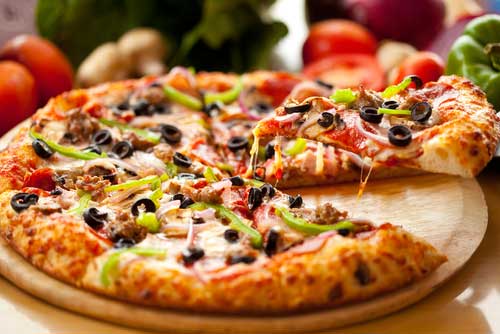
Why do most people crave sweet things, pizza, and chips rather than “good for you” stuff like spinach and broccoli? The desire to eat sweet things seems to be hard-wired into our brains, but that doesn’t mean we have to give in to those cravings. Giving in to sugar cravings creates a vicious cycle of more cravings and the urge for more unhealthy snacks. Don’t let the cravings get the best of you. Here are six steps you can take to curb the urge to eat the wrong foods and prevent carb cravings.
Carb Cravings Tip: Eat Breakfast Every Day
Do you begin the day with breakfast or head out the door on an empty stomach? New research shows eating breakfast helps curb cravings for sugary foods. Be sure your breakfast features protein. According to a new study, protein keeps cravings in check. How so? Eating protein boosts levels of a brain chemical called dopamine. Dopamine hooks up with receptors in your brain associated with “reward.” One reason people eat sugary foods is to get the good feelings dopamine offers. A high-protein breakfast gives the same dopamine release as sugar, yet won’t raise your blood sugar in the same way a chocolate chip cookie or a brownie will. Plus, protein keeps you feeling full and satisfied.
Carb Cravings Tip: Schedule More Snooze Time
Skimping on sleep not only makes you feel cranky: it increases carb cravings. Blame it on your appetite hormones. Research shows short changing yourself from a sleep standpoint increases hunger by its effects on leptin and ghrelin, two hormones that control appetite. As a result, you experience more cravings for high-carb foods. Being sleep deprived also weakens willpower. When you’re exhausted, it’s hard to resist a quick but false energy boost from eating something high in sugar.
In addition, the stress of too little sleep boosts cortisol, a stress hormone that increases the desire for something sweet. Research shows inadequate sleep, less than 7 hours a night, is linked with a greater risk for a number of health problems including obesity, type-2 diabetes, and heart disease. Make sure you’re getting your ZZs.
Carb Cravings Tip: Tame Stress
Did you know stress fuels carb cravings? When you’re stressed out after a hard day at work, you may seek comfort by biting into something that tastes good. Physiologically, carbohydrates increase the release of serotonin, a brain biochemical that has a calming effect. That’s why high-glycemic carbohydrates are what most people desire when they’re feeling anxious or “stressed out.” Unfortunately, comfort is short-term and the extra weight you put on creates other problems. It doesn’t help you banish stress either!
Learn to recognize when you’re snacking due to stress by keeping a journal. Write down what you ate, when you ate it, your level of hunger (on a scale of one to five) and how you were feeling at the time. You’ll quickly discover “stress eating” patterns. Then find another outlet for relieving stress. Some possibilities are yoga, deep breathing, meditation, listening to music, playing with a pet, writing in a journal, taking a warm bath or working on a hobby you enjoy. Make a list of things you love to do more than eating.
Carb Cravings Tip: Don’t Be a Calorie Restrictor
Sometimes cravings are a sign your energy stores are low and you need to refuel. If you’re cutting back calories to lose weight, make sure you’re not going too low or waiting too long between meals and snacks. When you become “stingy” with calories and energy stores drop too low, hunger becomes a natural reaction. When your body senses you’re low on fuel, it does what it can to help you get refueled. High-glycemic carbs become more appealing because they’re a fast source of energy. Make sure your body knows there’s no famine by supplying it with enough calories. Focus on diet quality, not on calorie counting.
Carb Cravings Tip: Eat a Blood Sugar Friendly Diet
Blood sugar drops trigger carb cravings. The key is to keep your blood sugar steady throughout the day. You can do this by choosing fiber-rich carbs from whole food sources like veggies. Combine healthy carbs with protein and a source of healthy fat. The combination of these three dietary components reduces blood sugar and insulin spikes and keeps you full until your next meal or snack. The worst approach is to eat or drink high-glycemic carbs alone. The resulting blood sugar and insulin spike spells trouble for your cravings – and your waistline.
Carb Cravings Tip: Eliminate Trigger Foods
If you know your downfall is sugary foods, make sure they’re out of reach. Clean out your cabinets, refrigerator, your desk drawer at the office, the glove compartment in your car and remove unhealthy snacks. Surround yourself with healthier alternatives. When you avoid sugary foods, your taste buds adapt over time, so you need less of that sweet sensation to feel satisfied.
Choose healthier alternatives when only something sweet will do. Fruit, low-sugar yogurt or a smoothie sweetened naturally with Stevia is a good alternative to ice cream or a brownie. Spread almond butter on an apple when you crave something sweet. The healthy fats and protein in the almond butter and the natural sweetness of the apple will satisfy a carb craving in a healthy manner.
The Bottom Line
Take control of your carb cravings before they control you. It takes time to change unhealthy eating patterns and curb cravings for the wrong foods, but be consistent and you’ll see results.
References:
Nutrition Journal, 2014; 13 (1): 97 DOI: 10.1186/1475-2891-13-97.
Medscape Family Medicine. “The Impact of Sleep Deprivation on Hormones and Metabolism” (2005)
Neurosci Biobehav Rev. 2008; 32(1): 20-39.
Related Articles By Cathe:
5 Reasons You Feel Sleepy & Less Productive after a Meal & What You Can Do about It
Why Women Crave Sugary Foods More Than Men
Can Eating a Nutrient Rich Diet Reduce Hunger?
The Important Role Macronutrients Play in Controlling Hunger

